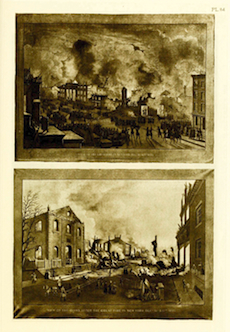The Skyscraper Museum is devoted to the study of high-rise building, past, present, and future. The Museum explores tall buildings as objects of design, products of technology, sites of construction, investments in real estate, and places of work and residence. This site will look better in a browser that supports web standards, but it is accessible to any browser or Internet device.
THE GREAT FIRE OF 1835

I. N. Phelps Stokes, The Iconography of Manhattan Island, Volume 3, PL 114. Retrieved from www.archive.org
On the frigid evening of December 16th, 1835, a fire erupted in a warehouse at the corner of Exchange and Pearl streets. The conflagration consumed around 650 buildings, and within an hour included the entire south side of the Wall Street to Broad Street. The opulent Merchant's Exchange, completed just twelve years earlier, caught fire around three in the morning, and its great dome collapsed a half hour later. The fire was finally brought under control when firefighters brought gunpowder from the Brooklyn Navy Yard to the base of Wall Street and created a firebreak. Two days later, an eyewitness account published in The Herald conveyed the devastation:
"On going down Wall street, I found it difficult to get through the crowd. The hose of the fire engines was run along the street and frozen. The front blocks of houses between Exchange Place and Pearl street, on Wall, was standing, behind which were all ruin and desolation. At the corner of Wall and Pearl, on looking southwardly, I saw a single ruin standing about half way to Hanover Square. I proceeded, climbing over the hot bricks, on the site, as I thought, of Pearl street, (but of that I am not sure) till I got to the single solitary wall that reared its head as if it was in mockery of the elemental war. On approaching, I read on the mutilated granite wall, "ARTH- TAP-N, 122 PE-L STREET." These were all the characters I could distinguish on the column. Two stories of this great wall were standing-the rest entirely in ruins. It was the only portion of a wall standing from the corner of Wall street to Hanover Square-for beyond that these are nothing but smoke, and fire, and dust."
